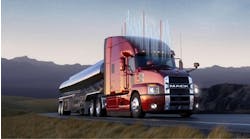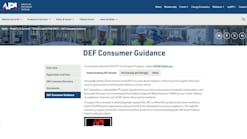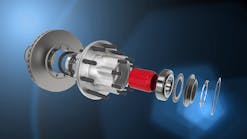CATERPILLAR has announced new horsepower ratings for its C11, C13, and C15 on-highway engines. At the top of the list are two new ratings for the C15, which will be offered with 625 hp and 600 hp versions beginning in the fall 2004. The new ratings complement the entire Cat engine line, the C7, C9, C11, C13, and C15, now all equipped with ACERT emission control technology.
The new 625 hp version of the C15 will be marketed as the “King of the Hill.” It develops 625 hp at 1,800 rpm and is rated at 595 hp at 2,100 rpm with a 38% torque rise. Built on the same platform as the 550 hp C15, the new engine rating provides 2,050 lb-ft torque at 1,200 rpm and a constant torque output all the way up to 1,700 rpm. In the 600 hp version, the C15 offers torque of 1,850 lb ft. Higher horsepower comes from higher flow turbochargers, a special camshaft, and a new generation electronic control module.
In addition to higher horsepower, the new engine is available with two retarder options. The Cat compression brake provides 600 hp of retarding power; the BrakeSaver hydraulic retarder delivers braking power of 260 hp. Combined, the two retarders can provide up to 725 hp of braking power, the maximum allowed for most drivelines.
Optional for C11 and C13
The compression brake is already available as an option for the C11 and C13 and in late 2004 will become available for all C15 ratings. The engine brake provides 330 retarding hp for the C11, 400 hp for the C13, and 600 hp for the C15. It is installed as an integral part of the engine and provides braking at any time as long as engine rpm is above 800 and no fuel is being supplied to the engine. The brake has two toggle switch controls — one to set the retarder operation in low, medium, or high mode, and a separate switch to energize the system. The engine brake is compatible with anti-lock braking systems; however, the engine brake may disengage if the ABS system detects wheel slippage.
In the fourth quarter 2004, Cat will offer five new ratings for the C13. Four of the ratings are at 470 hp and provide torque ratings of 1,550 lb-ft, 1,650 lb-ft, a multi-torque rating of 1,550/1750 lb-ft, and a 470 hp economy rating with a multi-torque output of 1,550/1,750 lb-ft. In addition, the C13 will be available with 500 hp and a 1,650 lb-ft torque rating.
The lightweight C11 engine will be offered at 350 hp or 370 hp, both with a torque rating of 1,450 lb-ft.
Cat says that its new EPA '04 compliant engines with ACERT technology have gained wide acceptance from fleets. The company has been following a “buy and test” program with customers with the result that many fleets are beginning to make repeat purchases. Cat says it has shipped more than 50,000 ACERT-equipped engines since production began in 2003. This gives Cat a 35% market share in the heavy-duty engine sector, the company says.
Many fleets are reporting fuel economy results at least as good as those posted by engines prior to the effective date of the new emission regulations, Cat says. Some engines have posted fuel economy performance as high as 6.6 miles per gallon.
Caterpillar says it will continue to develop ACERT technology and will make it the company's basis for meeting the more stringent emission regulations scheduled to become effective in 2007. EPA '07 engines should be available to fleets for testing sometime in the middle of 2005.
Cat continues to promote the “gear fast, run slow” approach to powertrain design that it began in the 1970s. The company now suggests lower numerical final drive ratios than ever before. For instance, many fleets seek improved fuel economy by running a high-horsepower, high-torque engine at low rpm through a final drive ratio of 3.70:1. Caterpillar says better fuel economy can be achieved without a noticeable loss of vehicle performance by coupling its new ACERT engines with driveline components with a final drive ratio as low as 3.36:1 or 3.25:1. To provide some context for such low numerical gear ratios, Cat is recommending final drive ratios often found on high performance, high speed sports cars.
In fact, Cat recently announced a new optional “Super Fuel Saver” multi-torque rating for C13 and C15 engines for combination with Eaton Roadranger RTLOC-16909A-T2 ten-speed transmissions. The engine/drivetrain combination is designed for optimum fuel economy at 65 miles per hour with the engine running at 1,325 rpm. The engine/transmission combination is said to improve fuel economy by as much as one-tenth mile per gallon.
To avoid loss of residual value at trade time, the engine and transmission package can be upgraded to performance levels more acceptable to owner-operators with the engine uprated to 500 hp with 1,650 lf-ft torque driving through a 13-speed RTLO-16913A transmission that allows the vehicle to cruise at 72 mph with the engine running 1,465 rpm.








